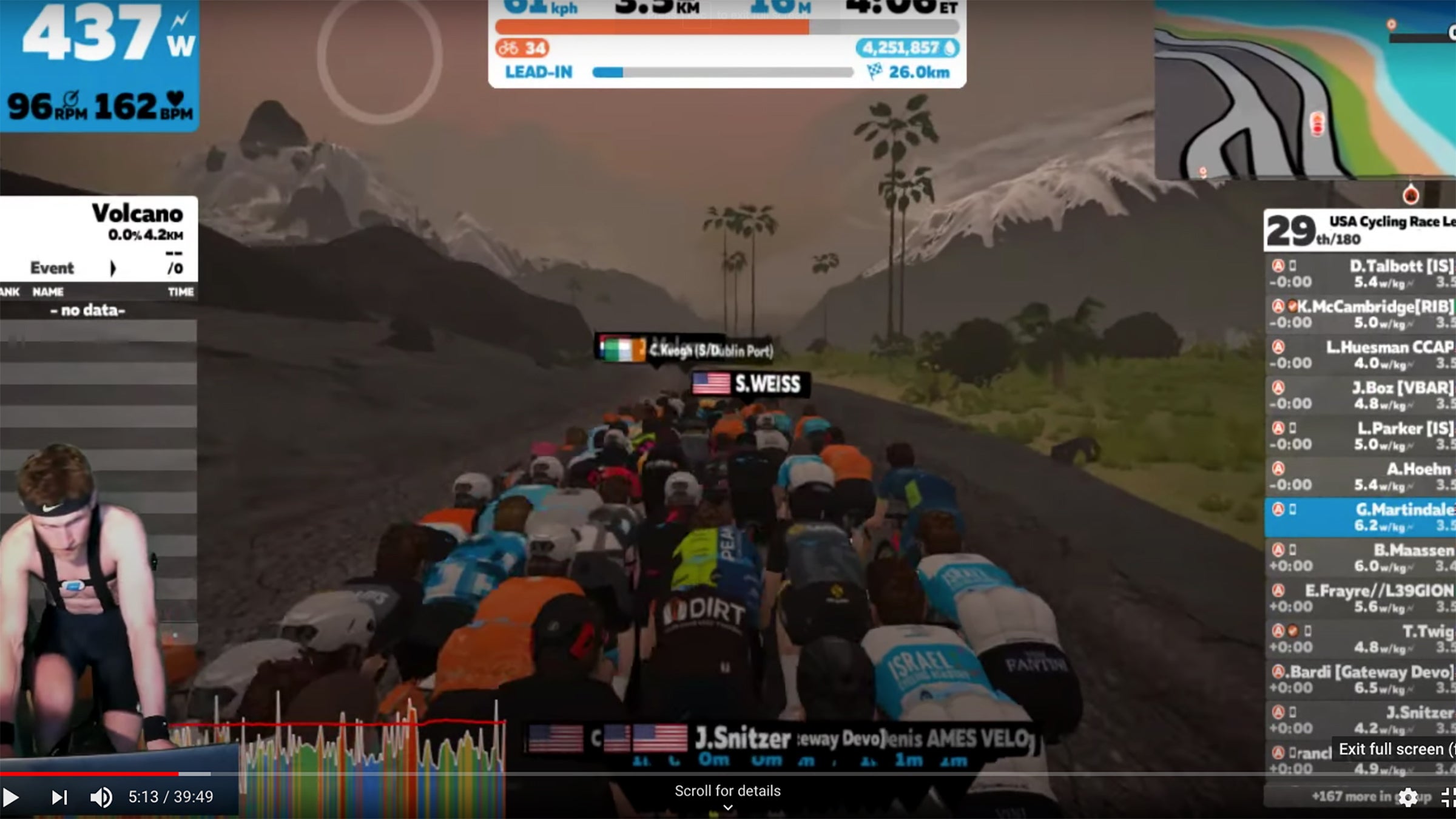9 Zwift Racing Tips from the Top-Ranked Men’s Team

While firing up your laptop, connecting your trainer, and then pedaling your way through the virtual world of cycling might seem pretty straightforward, racing in Zwift is quite different than racing on the road. We asked the number one ranked Zwift men’s team, Indoor Specialist, for tips on how how to go fast in the most popular virtual cycling environment.
1. Understand Trainer Difficulty Settings
In the Zwift Menu setting, you can adjust trainer difficulty, which controls how dramatic hills feel if you use a smart trainer. “If you set trainer difficulty to 50%, then a 10% gradient climb will feel like a 5% gradient, and if you set trainer difficulty to 0% then you won’t feel anything at all when the gradient changes in-game,” says Zwift U.S. national champion Holden Comeau. “You’ll still have to put out the same amount of watts to stay with your competitors.” The U.S. Zwift champ varies this setting to match a specific course profile, and how he’s feeling on a given day. “On flatter courses or time trials, where I know I’ll probably perform best if I have steady power for longer durations, I’ll lower trainer difficulty so that I’m less disrupted by the gradient change,” Comeau says. “But more typically I like the setting to be just under 50% because I like having the ability to soft-pedal on the descents.”

2. Keep Cool
When you’re cool, you’ll sweat less, and your heart rate will stay lower for longer, so fatigue will set in less quickly. Use a big fan—or two! Comeau uses two blower fans pointed at him, from the front at about 45 degrees on each side. He also has a dehumidifier—“because humidity [in an indoor environment] can spike throughout the course of the race”—and a portable air conditioner, too.
3. Warm Up
Most Zwift races start out really, really hard for two to three minutes. “If you’ve hopped on the trainer and go straight into the pen for a race, you’re in for a rude awakening,” says Indoor Specialist team founder Matt Gardiner. Give yourself 15 to 20 minutes before racing to get your blood flowing.

4. Eat, Drink, Repeat
Gardiner recommends fueling during Zwift races—not just for the event at hand, but to speed recovery for the next day’s racing or training. On Zwift, it’s possible to race day after day. A lack of attention to fuel for your efforts will lead to delayed recovery and compounded fatigue. For longer events, have a gel during your race, and don’t forget to keep hydrated.
5. Learn How to Move in the Pack
One of the most important—and challenging—skills to develop is learning how to move around in the peloton, which many riders on Zwift call the blob. Much like racing outside, if you’re not moving up, you’re probably moving back. And unlike outside, coasting is almost never a possibility. You have to stay on the gas. Some of the finer points are best learned through practice. “It is possible to predictably move around in the blob, and these movement behaviors can change relative to speed, power, pack size, equipment choice, and terrain,” Gardiner says.
6. Learn How to Climb
“The key is to follow others as best as you can. Most climbs on Zwift still have the benefit of the draft, so conserve precious energy and let others lead,” says Gardiner. Since some of the climbs in Zwift races are short and punchy, “the pace usually settles at the top of climbs, “so if you are at the front you can use this time to recover, or if you are chasing you can keep the power on over the top of climbs and get back into the pack as the leaders slow down,” he says.

7. Learn How to Sprint
Focus on speed—not power—which comes down to position and timing in the final meters of a race. Comeau, a sprinting specialist, focuses on generating peak power in as few pedal strokes as possible. When should you kick for the line? Consider how hard has the race has been so far, how tired you are, how fast the bunch is going before the sprint, and who you’re racing. But generally, as with sprinting outside, the longer you can stay in the draft, the better off you are to unleash your sprint at the end.
8. Choose a Course that Suits Your Abilities
When previewing events in Zwift or the Companion app, you can see how much elevation gain a given course has. Gardiner recommends racing to your strengths. “If you join a race up the Alpe du Zwift, but you haven’t been training for a 1,100m climb in one go, that race is not going to be very much fun,” he says. “Sprinter? Go rip on the Crit City courses! Puncheur? Yorkshire and the Innsbruckring courses are for you!”

9. Use Technology to Get Social
One of the greatest features of Zwift is the ability to easily connect with other cyclists around the world, at any time of day. “If you’re routinely riding the same time of day, you’ll start to recognize others doing the same thing,” observes Gardiner. “Connect with them using the Zwift Companion app and team up.” Team Indoor Specialist uses the Discord voice chat app to talk during races. “It adds so much to the game to be connected with individuals while you’re riding,” he says.
Bonus Tip for Advanced Racers: Do Your Research on Zwiftpower
If you’re racing a lot on Zwift, you should consider registering on Zwiftpower.com which provides official results for all Zwift races. “Before your race, check out who is registered, and scope out the competition’s abilities, race history, and link to their Strava profile to see what they’re capable of,” says Indoor Specialist rider Ryan Larson. Knowing your opponents can be an advantage in following the right attack mid-race, and not chasing down a decoy.